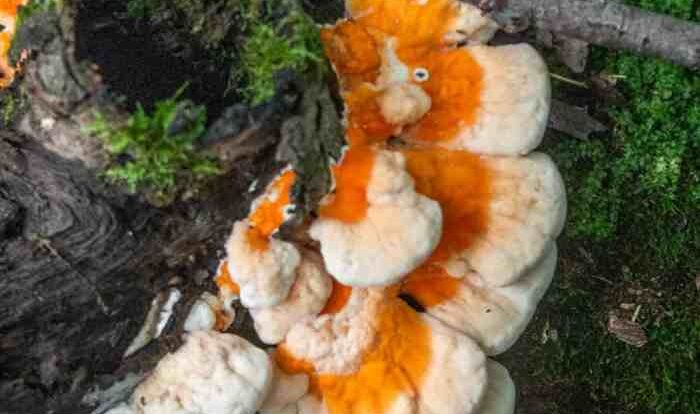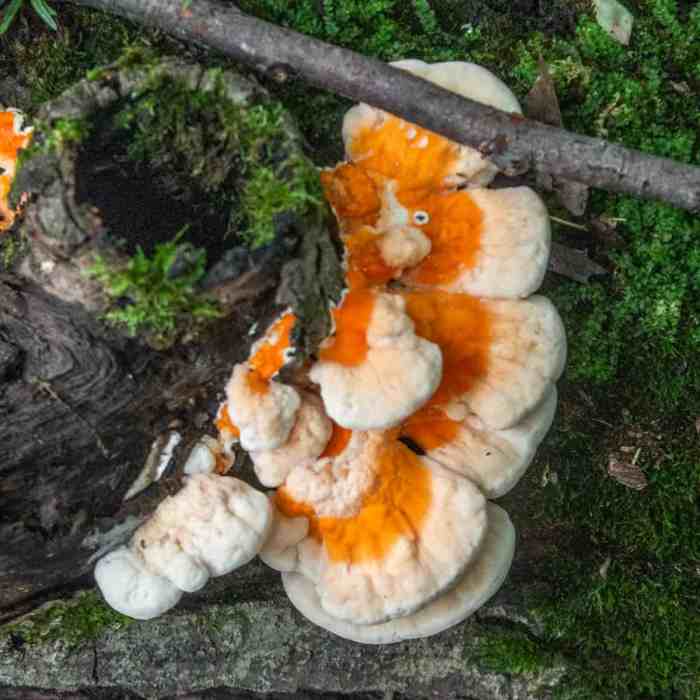
Chicken of the woods recipe – Embark on a culinary adventure with chicken of the woods, a vibrant wild mushroom that tantalizes taste buds and sparks curiosity. This guide delves into the diverse recipes, nutritional benefits, foraging techniques, and culinary applications of this delectable delicacy.
From sautéing to grilling and roasting, discover a range of cooking methods that showcase the versatility of chicken of the woods. Explore the symphony of flavors created by pairing it with various ingredients and seasonings.
Recipe Variations

Chicken of the woods is a versatile mushroom that can be cooked in a variety of ways. Here are a few of our favorite recipes:
Sautéed chicken of the woods is a quick and easy way to enjoy this delicious mushroom. Simply heat some olive oil in a skillet over medium heat and add the chicken of the woods. Cook until the mushrooms are browned and tender, about 5 minutes.
Season with salt and pepper to taste.
Grilled Chicken of the Woods
Grilled chicken of the woods is a great way to enjoy the smoky flavor of this mushroom. Preheat your grill to medium heat and brush the chicken of the woods with olive oil. Grill the mushrooms for 5-7 minutes per side, or until they are cooked through.
Roasted Chicken of the Woods
Roasted chicken of the woods is a hearty and flavorful dish. Preheat your oven to 400 degrees Fahrenheit and toss the chicken of the woods with olive oil, salt, and pepper. Roast the mushrooms for 20-25 minutes, or until they are browned and tender.
Using Various Ingredients and Seasonings
Chicken of the woods can be used in a variety of dishes, from soups and stews to pizzas and pastas. It pairs well with a variety of ingredients, including garlic, onions, thyme, rosemary, and sage. You can also add some heat to your dish with chili peppers or cayenne pepper.
Nutritional Value and Health Benefits

Chicken of the woods is not only a delectable mushroom, but it also packs a nutritional punch. It’s a rich source of vitamins, minerals, and antioxidants, making it a healthy addition to any diet.
One cup of cooked chicken of the woods provides:
- Calories: 120
- Protein: 12 grams
- Fiber: 8 grams
- Vitamin C: 20% of the Daily Value (DV)
- Vitamin D: 10% of the DV
- Potassium: 10% of the DV
- Iron: 6% of the DV
Health Benefits
In addition to its nutritional value, chicken of the woods has been linked to several potential health benefits, including:
- Antioxidant activity:Chicken of the woods contains several antioxidants, including ergothioneine and beta-glucans, which may help protect cells from damage caused by free radicals.
- Anti-inflammatory properties:Some studies have shown that chicken of the woods may have anti-inflammatory effects, which could be beneficial for conditions such as arthritis and asthma.
- Immune system support:Chicken of the woods is a good source of beta-glucans, which are known to support the immune system.
It’s important to note that more research is needed to fully understand the health benefits of chicken of the woods. However, the current evidence suggests that it’s a healthy and nutritious mushroom that may offer several potential benefits.
Foraging and Identification
Foraging for chicken of the woods is an exciting and rewarding experience. This versatile mushroom can be found in various habitats and is easily recognizable by its vibrant colors and unique shape. To ensure a safe and successful foraging expedition, it’s essential to have a thorough understanding of its characteristics and distinguishing features.
Habitat and Characteristics
Chicken of the woods typically grows on dead or decaying hardwood trees, particularly oak, maple, and beech. It can be found in both deciduous and mixed forests, often at the base of trees or on fallen logs. The mushroom has a bright orange to yellow coloration, with a velvety or suede-like texture.
It forms large, shelf-like structures that can range in size from a few inches to several feet across.
Safe Identification
While chicken of the woods is generally easy to identify, it’s crucial to exercise caution to avoid poisonous lookalikes. One key characteristic to look for is the presence of “pores” on the underside of the mushroom’s cap. These pores, rather than gills, are tiny holes that release spores.
Have you heard of the chicken of the woods recipe ? It’s a delicious and unique mushroom that tastes like chicken. You can find it in the wild during the fall months, or you can purchase it at some specialty grocery stores.
If you’re looking for a new and exciting way to cook mushrooms, give this recipe a try.
Additionally, the flesh of chicken of the woods should be white and firm, with a mild, slightly fruity odor.
Best Time to Forage
The optimal time to forage for chicken of the woods varies depending on the region. In general, it is most commonly found during the late summer and fall months, when temperatures are moderate and there is ample moisture. However, it can also be found in the spring or winter in some areas, depending on the weather conditions.
Culinary Uses and Pairings

Chicken of the woods is a versatile culinary mushroom that can be used in a variety of dishes. Its texture is meaty and slightly chewy, with a flavor that is reminiscent of chicken or crab. Chicken of the woods is also a good source of protein, fiber, and vitamins.
Chicken of the woods can be paired with a variety of other ingredients, including vegetables, sauces, and spices. Some popular pairings include:
Vegetables
- Onions
- Garlic
- Bell peppers
- Mushrooms
- Asparagus
Sauces
- Cream sauces
- Tomato sauces
- Wine sauces
- Soy sauces
Spices
- Salt
- Pepper
- Garlic powder
- Onion powder
- Paprika
Chicken of the woods can be used to prepare a variety of dishes, including:
Soups and stews
Chicken of the woods is a hearty addition to soups and stews. It can be added to the pot whole or chopped, and it will cook down to a tender and flavorful texture.
Stir-fries
Chicken of the woods is a great addition to stir-fries. It can be cooked with other vegetables, such as onions, peppers, and mushrooms, and it will add a meaty flavor to the dish.
Omelets and scrambles
Chicken of the woods can be added to omelets and scrambles for a protein-packed breakfast. It can be cooked with other ingredients, such as cheese, vegetables, and meat, and it will add a unique flavor to the dish.
Another great chicken of the woods recipe is to sauté it with some garlic and olive oil. This is a simple but flavorful dish that can be served as a side or main course. You can also add some other vegetables to the sauté, such as onions, peppers, or zucchini.
Preservation and Storage

Preserving chicken of the woods extends its shelf life and allows you to enjoy its unique flavor year-round. Drying, freezing, and canning are the most common methods for preserving this mushroom.
Drying, Chicken of the woods recipe
Drying chicken of the woods is a simple and effective way to preserve it. Slice the mushrooms into thin strips and spread them out on a baking sheet lined with parchment paper. Bake at the lowest oven setting (usually around 150°F or 65°C) for several hours, or until the mushrooms are completely dry and brittle.
Store the dried mushrooms in an airtight container in a cool, dry place for up to 6 months.
Freezing
Freezing is another great way to preserve chicken of the woods. Clean the mushrooms and cut them into desired sizes. Blanch the mushrooms in boiling water for 2-3 minutes, then drain and cool them quickly. Freeze the blanched mushrooms in airtight containers or freezer bags for up to 6 months.
Canning
Canning chicken of the woods is a more involved process, but it allows you to store the mushrooms for extended periods. Clean the mushrooms and cut them into small pieces. Combine the mushrooms with a brine solution (1 cup water to 1/2 cup salt) and bring to a boil.
Pack the hot mushrooms into sterilized jars and seal them according to the manufacturer’s instructions. Process the jars in a boiling water bath for 90 minutes. Store the canned mushrooms in a cool, dark place for up to 1 year.
Final Conclusion

As you venture into the world of chicken of the woods, remember the importance of responsible foraging and safe identification. With knowledge as your compass, unlock the culinary treasures of this woodland wonder and create dishes that will captivate your senses.
Common Queries: Chicken Of The Woods Recipe
What are the key characteristics of chicken of the woods?
Chicken of the woods is known for its bright orange color, fleshy texture, and shelf-like growth pattern on trees.
How can I safely identify chicken of the woods?
Look for the distinctive orange color, avoid mushrooms with white gills, and consult field guides or expert foragers.
What are the nutritional benefits of chicken of the woods?
It is rich in vitamins, minerals, and antioxidants, including vitamin D, potassium, and ergothioneine.





